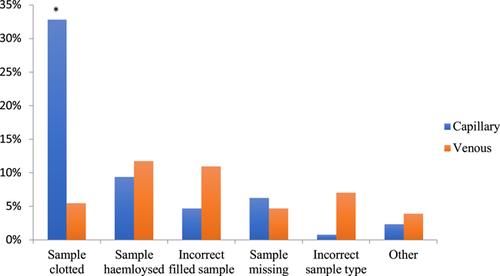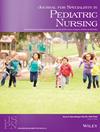Capillary blood sampling increases the risk of preanalytical errors in pediatric hospital care: Observational clinical study
Abstract
Purpose
The blood sampling procedure is complex and prone to failure, as reflected by preanalytical errors in pediatric hospital care. The primary aim was to evaluate if the risk of preanalytical errors was higher with capillary blood sampling than with venous blood sampling, and secondary, explore specific factors associated with preanalytical errors, both overall and stratified by capillary and venous blood sampling.
Design and Methods
This observational pediatric hospital study collected outcomes from medical records and blood sampling surveys from year 2014 to 2016. The risk of preanalytical errors was analyzed with adjusted-odds ratio (adj-OR) by multivariable logistic regression with 95% confidence intervals (CIs).
Results
Overall, 128 (13%) preanalytical errors were identified among 951 blood samples. The proportion and adj-OR of errors was significantly higher in capillary compared with venous blood samples, 72 (20%) of 354 versus 56 (9.4%) of 597, p = .001, adj-OR 2.88 (CI 1.79–4.64). Blood collection with multiple sample tubes was significantly associated with increased risk of preanalytical errors (n = 97 of 601, 16%), while log weight (kg) significantly decreased the risk of preanalytical errors adj-OR 0.66 (CI 0.50–0.86), indicating a protective effect of increasing weight. However, stratified analyses indicated a protective effect of increasing log weight for venous blood sampling adj-OR 0.52 (CI 0.38–0.72), but not capillary blood sampling, adj-OR 1.08 (CI 0.76–1.55).
Conclusion
This study indicates that capillary blood sampling collection increases the risk of preanalytical errors. Further, a child's increasing body weight reduced the risk of preanalytical errors, while multiple sample tube collections significantly increased the risk of preanalytical errors.
Practice Implications
This new information may help nurses improve their knowledge concerning blood sampling collection in pediatrics. Altogether, this study also indicates that implementing more venous blood sampling and improve the cases of capillary sampling could reduce the number of preanalytical errors in pediatric hospitals.


 求助内容:
求助内容: 应助结果提醒方式:
应助结果提醒方式:


